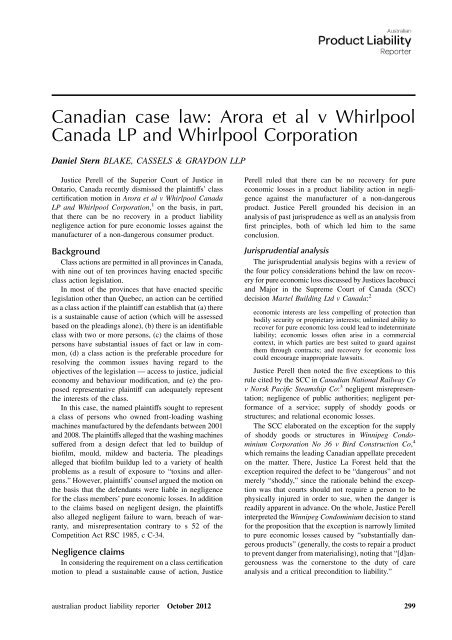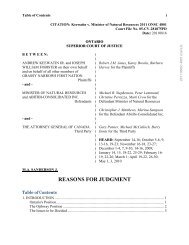Canadian case law: Arora et al v Whirlpool Canada LP and ...
Canadian case law: Arora et al v Whirlpool Canada LP and ...
Canadian case law: Arora et al v Whirlpool Canada LP and ...
- No tags were found...
Create successful ePaper yourself
Turn your PDF publications into a flip-book with our unique Google optimized e-Paper software.
<strong>Canadian</strong> <strong>case</strong> <strong>law</strong>: <strong>Arora</strong> <strong>et</strong> <strong>al</strong> v <strong>Whirlpool</strong><strong>Canada</strong> <strong>LP</strong> <strong>and</strong> <strong>Whirlpool</strong> CorporationDaniel Stern BLAKE, CASSELS & GRAYDON L<strong>LP</strong>Justice Perell of the Superior Court of Justice inOntario, <strong>Canada</strong> recently dismissed the plaintiffs’ classcertification motion in <strong>Arora</strong> <strong>et</strong> <strong>al</strong> v <strong>Whirlpool</strong> <strong>Canada</strong><strong>LP</strong> <strong>and</strong> <strong>Whirlpool</strong> Corporation, 1 on the basis, in part,that there can be no recovery in a product liabilitynegligence action for pure economic losses against themanufacturer of a non-dangerous consumer product.BackgroundClass actions are permitted in <strong>al</strong>l provinces in <strong>Canada</strong>,with nine out of ten provinces having enacted specificclass action legislation.In most of the provinces that have enacted specificlegislation other than Quebec, an action can be certifiedas a class action if the plaintiff can establish that (a) thereis a sustainable cause of action (which will be assessedbased on the pleadings <strong>al</strong>one), (b) there is an identifiableclass with two or more persons, (c) the claims of thosepersons have substanti<strong>al</strong> issues of fact or <strong>law</strong> in common,(d) a class action is the preferable procedure forresolving the common issues having regard to theobjectives of the legislation — access to justice, judici<strong>al</strong>economy <strong>and</strong> behaviour modification, <strong>and</strong> (e) the proposedrepresentative plaintiff can adequately representthe interests of the class.In this <strong>case</strong>, the named plaintiffs sought to representa class of persons who owned front-loading washingmachines manufactured by the defendants b<strong>et</strong>ween 2001<strong>and</strong> 2008. The plaintiffs <strong>al</strong>leged that the washing machinessuffered from a design defect that led to buildup ofbiofilm, mould, mildew <strong>and</strong> bacteria. The pleadings<strong>al</strong>leged that biofilm buildup led to a vari<strong>et</strong>y of he<strong>al</strong>thproblems as a result of exposure to “toxins <strong>and</strong> <strong>al</strong>lergens.”However, plaintiffs’ counsel argued the motion onthe basis that the defendants were liable in negligencefor the class members’ pure economic losses. In additionto the claims based on negligent design, the plaintiffs<strong>al</strong>so <strong>al</strong>leged negligent failure to warn, breach of warranty,<strong>and</strong> misrepresentation contrary to s 52 of theComp<strong>et</strong>ition Act RSC 1985, c C-34.Negligence claimsIn considering the requirement on a class certificationmotion to plead a sustainable cause of action, JusticePerell ruled that there can be no recovery for pureeconomic losses in a product liability action in negligenceagainst the manufacturer of a non-dangerousproduct. Justice Perell grounded his decision in anan<strong>al</strong>ysis of past jurisprudence as well as an an<strong>al</strong>ysis fromfirst principles, both of which led him to the sameconclusion.Jurisprudenti<strong>al</strong> an<strong>al</strong>ysisThe jurisprudenti<strong>al</strong> an<strong>al</strong>ysis begins with a review ofthe four policy considerations behind the <strong>law</strong> on recoveryfor pure economic loss discussed by Justices Iacobucci<strong>and</strong> Major in the Supreme Court of <strong>Canada</strong> (SCC)decision Martel Building Ltd v <strong>Canada</strong>: 2economic interests are less compelling of protection thanbodily security or propri<strong>et</strong>ary interests; unlimited ability torecover for pure economic loss could lead to ind<strong>et</strong>erminateliability; economic losses often arise in a commerci<strong>al</strong>context, in which parties are best suited to guard againstthem through contracts; <strong>and</strong> recovery for economic losscould encourage inappropriate <strong>law</strong>suits.Justice Perell then noted the five exceptions to thisrule cited by the SCC in <strong>Canadian</strong> Nation<strong>al</strong> Railway Cov Norsk Pacific Steamship Co: 3 negligent misrepresentation;negligence of public authorities; negligent performanceof a service; supply of shoddy goods orstructures; <strong>and</strong> relation<strong>al</strong> economic losses.The SCC elaborated on the exception for the supplyof shoddy goods or structures in Winnipeg CondominiumCorporation No 36 v Bird Construction Co, 4which remains the leading <strong>Canadian</strong> appellate precedenton the matter. There, Justice La Forest held that theexception required the defect to be “dangerous” <strong>and</strong> notmerely “shoddy,” since the ration<strong>al</strong>e behind the exceptionwas that courts should not require a person to bephysic<strong>al</strong>ly injured in order to sue, when the danger isreadily apparent in advance. On the whole, Justice Perellinterpr<strong>et</strong>ed the Winnipeg Condominium decision to st<strong>and</strong>for the proposition that the exception is narrowly limitedto pure economic losses caused by “substanti<strong>al</strong>ly dangerousproducts” (gener<strong>al</strong>ly, the costs to repair a productto prevent danger from materi<strong>al</strong>ising), noting that “[d]angerousnesswas the cornerstone to the duty of carean<strong>al</strong>ysis <strong>and</strong> a critic<strong>al</strong> precondition to liability.”austr<strong>al</strong>ian product liability reporter October 2012 299
















